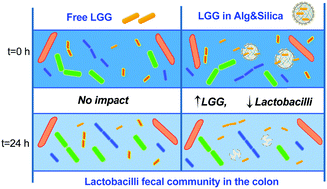Original behavior of L. rhamnosus GG encapsulated in freeze-dried alginate–silica microparticles revealed under simulated gastrointestinal conditions†
Abstract
The probiotic bacteria L. rhamnosus GG (LGG) were encapsulated into core–shell alginate–silica microbeads of about 500 μm through a double step synthesis involving micro-ionogel formation by electrospraying and silica coating by the sol–gel process. Formulating microparticles with sucrose as a cryoprotectant allowed maintaining bacterial viability and cultivability upon freeze-drying for weeks, as determined by plate counting. As much as 3.4 × 1010 CFU g−1 and 4.1 × 108 CFU g−1 were observed to be cultivable in alginate and silica-coated beads after 3 weeks of freeze-drying, respectively. The viability of the released bacteria was evaluated in an in vitro batch SHIME model (a simulator of the human intestinal microbial ecosystem) by denaturing gradient gel electrophoresis (DGGE) and quantitative PCR (qPCR). It was revealed that microencapsulation efficiently protects LGG from the low gastric pH, especially in the case of silica-coated beads. Both encapsulation systems (alginate and alginate–silica) allowed for a better colonization of the colon compared with free LGG. Interestingly, although metabolically inactive in the upper digestive tract, LGG released from silica-coated beads boost their metabolism once they arrive in the colon, where they outcompete other members from the Lactobacillus community. In view of these results, we show that silica, usually used as an anti-caking agent in food powders, can play an active role in probiotics delivery and colon colonization.



 Please wait while we load your content...
Please wait while we load your content...